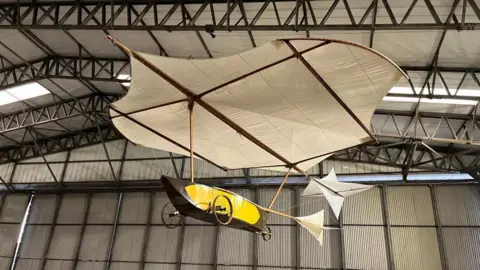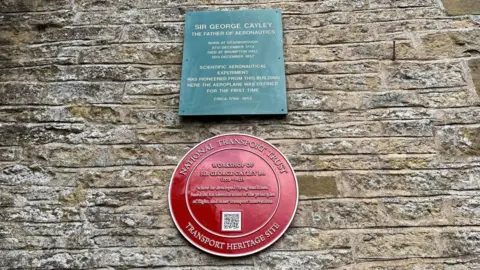'We need to remember Father of Aviation' - family
 Getty Images
Getty ImagesAn innovative MP who invented an aircraft and tested it 50 years before the Wright brothers' famous flight should be "celebrated more", one of his descendants has said.
Sir George Cayley, who represented Scarborough in the House of Commons, developed the world's first manned, fixed-wing glider when he was in his 70s.
Nicknamed the "father of aviation", Sir George sent a servant up for its first flight in Brompton Dale in 1853.
His four-times great-grandson, Sir William Worsley of Hovingham Hall, said his ancestor was "one of our greatest Yorkshiremen and it is important that he is recognised. I think Yorkshire should be dead proud of him."
 BBC/Julia Lewis
BBC/Julia LewisSir William added: "Not only did he invent the flying machine, but he discovered and understood the principles of flight.
"He was an extraordinarily clever person and I'm immensely proud of him."
Sir William admitted that the glider only covered a distance of 200 yards before it crash landed.
"Sir George was in his 70s by the time he invented the flying machine, so he didn't fly it, he sent his coachman up in the plane and when it crashed, he broke his leg. He wasn't very happy about this. So he got out and said to Sir George 'I was hired to drive a coach not to fly your contraptions', and handed in his notice.
"I do feel for the coachman because it must have been quite terrifying."
Sir William pointed out that after the Wright brothers' first powered flight in 1903, they paid tribute to Sir George's pioneering work.
"Without him, they couldn't have done what they did."
The talented Victorian engineer also invented self-righting lifeboats, the tension-spoke wheel, caterpillar tracks, seatbelts and small-scale helicopters.
"I think he was a great inventor. In today's world you invent the internet but to have invented the flying machine is an extraordinary thing to have done, it's really rather exciting."
 BBC/Julia Lewis
BBC/Julia LewisA replica of the Cayley glider is on display at the Yorkshire Air Museum, where it is described as the "spark-point" of flight.
Communications manager Jerry Ibbotson said: "Without this we would still be on terra firma. Without this glider, no other aircraft would exist. This is the foundation stone of aviation.
"The key thing is it has a wooden spa running the length of it which is bowed, it's not flat. So the canvas on top of it is not a flat surface, it's an aerofoil shape and that's what he invented and that's why things fly.
Mr Ibbotson agreed that Sir George should be better recognised.
"People who understand the world of aviation understand how important his work was because it wasn't just the thing that he built, it was the principles behind it.
"Even Formula One cars use that principle, turned upside down so their cars at 200mph don't take off. They've taken Cayley's wing, flipped it upside down into a spoiler that keeps the car on the ground.
"Sir George Cayley should be talked about in school history lessons. His story cries out to be told."
 BBC/Julia Lewis
BBC/Julia LewisA plaque commemorating Sir George's achievements has been placed on the side of his former workshop at Brompton Hall, the Cayley family seat which is now a school, by the National Transport Trust.
Jerry Swift, deputy chair of the trust, agreed that the Whig MP had made a considerable impact on aviation.
"Sir George was an incredible inventor and a pioneer of aeronautical engineering.
"He identified the four forces which act on a heavier-than-air flying vehicle: weight, lift, drag and thrust.
"We may not know him well in the UK, but the Wright brothers credited Cayley with much of their thinking that led to the famous flights at Kitty Hawk.
"Modern aeroplane design is based on his discoveries."
Listen to highlights from North Yorkshire on BBC Sounds, catch up with the latest episode of Look North or tell us a story you think we should be covering here.
